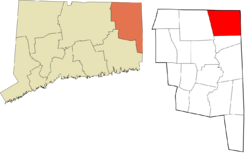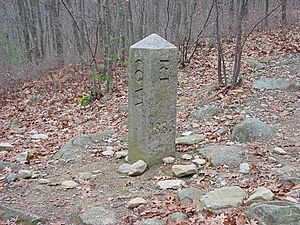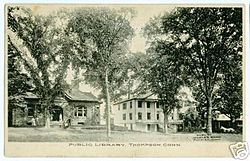Thompson, Connecticut facts for kids
Quick facts for kids
Thompson, Connecticut
|
||
|---|---|---|
| Town of Thompson | ||
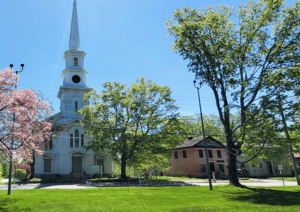
View from the Thompson Common
|
||
|
||
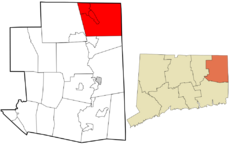 Windham County and Connecticut Windham County and Connecticut |
||
| Country | ||
| U.S. state | ||
| County | Windham | |
| Region | Northeastern CT | |
| Incorporated | 1785 | |
| Government | ||
| • Type | Selectman-town meeting | |
| Area | ||
| • Total | 48.7 sq mi (126.1 km2) | |
| • Land | 46.9 sq mi (121.6 km2) | |
| • Water | 1.7 sq mi (4.4 km2) | |
| Elevation | 469 ft (143 m) | |
| Population
(2020)
|
||
| • Total | 9,189 | |
| • Density | 188.69/sq mi (72.87/km2) | |
| Time zone | UTC-5 (Eastern) | |
| • Summer (DST) | UTC-4 (Eastern) | |
| ZIP code |
06255, 06262, 06277
|
|
| Area code(s) | 860/959 | |
| FIPS code | 09-75870 | |
| GNIS feature ID | 0213516 | |
Thompson is a town located in Windham County, Connecticut, United States. It's part of the Northeastern Connecticut Planning Region. The town was named after Sir Robert Thompson, an important English landholder. In 2020, about 9,189 people lived here.
Thompson is in the very northeast corner of Connecticut. It shares borders with towns in Massachusetts and Rhode Island. These include Webster, Massachusetts, Dudley, Massachusetts, Douglas, Massachusetts, and Burrillville, Rhode Island. It also borders Woodstock, Connecticut and Putnam, Connecticut within Connecticut.
Thompson is famous for the Thompson Speedway Motorsports Park. This race track has the highest banks in New England. It hosts a huge event called The World Series of Auto Racing every fall. About 400 cars and 16 different racing groups come to compete. Another cool fact is that the Tri-State Marker is right on Thompson's border. This marker shows where Connecticut, Rhode Island, and Massachusetts meet. The phrase "Swamp Yankee" might have started in Thompson during the American Revolution in 1776. Long ago, Thompson was also the site of an Indian village called Maanexit.
Thompson was also where the Great East Thompson Train Wreck happened in 1891. This was one of the worst train wrecks in American history. It was the only one to involve four trains at once.
Contents
Exploring Thompson's Geography
Thompson covers about 48.7 square miles. Most of this area, about 46.9 square miles, is land. The rest, about 1.7 square miles, is water.
Thompson has many small ponds, like Little Pond and Long Pond. It also has two main lakes: West Thompson Lake and Quaddick Reservoir. Several rivers flow through the town. These include the French River and Five Mile River. Both of these rivers flow into the Quinebaug River, which also runs through Thompson.
One of the highest spots in Thompson is Fort Hill. It stands about 649 feet (198 meters) above sea level. The town is located about 64 miles southwest of Boston. It's also 110 miles northeast of Bridgeport. Thompson is on the 42nd parallel north. This means it's on the same line of latitude as the northern parts of Rome, Italy.
A cool geological feature here is the Wilsonville Fault. This fault line was formed almost 200 million years ago. It appeared when the supercontinent Pangaea began to break apart.
Neighboring Towns
Thompson shares its borders with these towns:
- Burrillville, Rhode Island
- Douglas, Massachusetts
- Dudley, Massachusetts
- Webster, Massachusetts
- Putnam
- Woodstock
Thompson's Villages
Thompson is made up of ten smaller communities called villages:
- East Thompson
- Fabyan
- Grosvenordale
- Mechanicsville
- North Grosvenordale (This includes the North Grosvenordale Mill Historic District).
- Quaddick
- Quinebaug
- Thompson Hill (This includes the Thompson Hill Historic District).
- West Thompson
- Wilsonville
People of Thompson: Demographics
| Historical population | |||
|---|---|---|---|
| Census | Pop. | %± | |
| 1820 | 2,928 | — | |
| 1840 | 3,535 | — | |
| 1850 | 4,638 | 31.2% | |
| 1860 | 3,259 | −29.7% | |
| 1870 | 3,804 | 16.7% | |
| 1880 | 5,051 | 32.8% | |
| 1890 | 5,580 | 10.5% | |
| 1900 | 6,442 | 15.4% | |
| 1910 | 4,804 | −25.4% | |
| 1920 | 5,055 | 5.2% | |
| 1930 | 4,999 | −1.1% | |
| 1940 | 5,577 | 11.6% | |
| 1950 | 5,585 | 0.1% | |
| 1960 | 6,217 | 11.3% | |
| 1970 | 7,580 | 21.9% | |
| 1980 | 8,141 | 7.4% | |
| 1990 | 8,668 | 6.5% | |
| 2000 | 8,878 | 2.4% | |
| 2010 | 9,458 | 6.5% | |
| 2020 | 9,189 | −2.8% | |
| U.S. Decennial Census | |||
In 2010, Thompson had 9,458 people living there. There were 3,730 households and 2,587 families. The town had about 201.7 people per square mile. There were 4,171 housing units, with about 88.9 units per square mile.
Most of the people in Thompson were White (95.6%). A smaller number were African American (0.6%), Native American (0.4%), or Asian (0.7%). About 1.8% of the population was Hispanic or Latino.
About 28.3% of households had children under 18 living with them. Most households (55.7%) were married couples. The average household had 2.51 people, and the average family had 2.98 people.
The population was spread out by age. About 21.8% were under 18. About 14.6% were 65 years or older. The average age in Thompson was 43 years old.
The median income for a household was $63,385. For families, the median income was $75,652. The average income per person in the town was $29,044. About 7.5% of the population lived below the poverty line.
Schools in Thompson
Thompson has a public school system where the elementary, middle, and high school buildings are all connected.
- The Mary R. Fisher Memorial Elementary School teaches students from Pre-K to 4th grade.
- Thompson Middle School has students in grades 5 through 8.
- Tourtellotte Memorial High School serves students in grades 9 through 12.
There are also private schools in town. St. Joseph's School is a Catholic school for grades Pre-K to 8. Marianapolis Preparatory is a high school located on the historic Thompson Hill.
The original Tourtellotte Memorial High School building was built in a style called Greek Revival. It opened in 1909. The school is named after Dr. Jacob F. Tourtellotte. He was a surgeon in the U.S. Navy during the Civil War. The school also has a small museum called the "Memorial Room." It holds portraits and belongings of Dr. Tourtellotte and his family. The local historical society takes care of it.
Marianapolis Preparatory School started in 1926. It was sponsored by the Congregation of Marians. The school is on what used to be the Ream Estate. Norman Bruce Ream, who owned the estate, was a director for big companies like The Pullman Company and U.S. Steel. The main mansion, "Carolyn Hall," burned down in 1964. A new school building was built in its place.
Thompson's Libraries
The Thompson Public Library is located at 934 Riverside Drive in North Grosvenordale. It's part of the town's Community Center. The library is very large, with 20,400 square feet of space. It holds 55,000 items, including books, magazines, CDs, and DVDs. You can also find online resources there.
The library first opened in 1902 with 1,370 books. It was in a small building on Thompson Hill. This building is now known as the Ellen Larned Memorial Library. Over the years, the library had two branch locations. The Quinebaug Branch operated from 1961 to 1994. The Grosvenordale Branch was open from 1958 to 1966.
Thompson was the first small town in Connecticut to have a bookmobile service. This mobile library operated from 1966 to 1993. The current library building in North Grosvenordale was finished in 1994.
Notable People from Thompson
Many interesting people have connections to Thompson:
- Marietta Stanley Case (1845–1900) was an author and someone who spoke out against alcohol.
- Emma Shaw Colcleugh (1846–1940) was a journalist, speaker, traveler, and collector.
- George Whitefield Davis (1839–1918) was an engineer and a Major General in the U.S. Army. He was born in Thompson. He also served as a military governor for Puerto Rico and the Panama Canal Zone.
- James Hillman (1926–2011) was a famous psychologist. He died at his home in Thompson.
- Simon Larned (1753–1817) was a captain in the American Revolutionary War. He was also a colonel in the War of 1812 and a U.S. Congressman. He was born in Thompson.
- Andrew Mamedoff (1912–1941) was a pilot who fought for the RAF in World War II. He was born in Thompson.
- James Brown Mason (1775–1819) was a U.S. Congressman for Rhode Island for two terms. He was born in Thompson.
- Ossian Everett Mills (1846–1920) started the Phi Mu Alpha Sinfonia music group. He was born and buried in Thompson.
- James M. Munyon (1848–1918) was a publisher and a doctor. He was born in Thompson.
- General Stafford (1868–1923) was a baseball player. He was born in Thompson.
- Daniel Takawambait (1652–1716) was the first Native American pastor in colonial America.
- Raymond S. Thatcher (1903–1988) was the Connecticut State Comptroller for 10 years.
- John E. Tourtellotte (1869–1939) was an architect. He was born in East Thompson.
- Ithiel Town (1784–1844) was an architect and civil engineer. He was born in Thompson.
- Anastasy Vonsiatsky (1898–1965) was a Russian political leader. He lived and is buried in Thompson.
See also
 In Spanish: Thompson (Connecticut) para niños
In Spanish: Thompson (Connecticut) para niños



